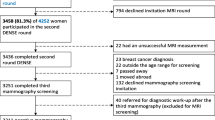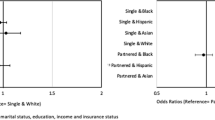Abstract
Prior research has found that women with disabilities have often experienced disparities in receipt of cervical cancer screening. However, there is a research gap regarding receipt of cervical cancer screening by types of disability. This study examined the differences in receiving cervical cancer screening through self-reported Pap testing among women by disability type. This cross-sectional study analyzed data from the 2016, 2018, and 2020 Behavioral Risk Factor and Surveillance System (BRFSS). The relative risk of cervical cancer screening through self-reported Pap tests received within the past three years among women aged 21–65 by disability type was compared using modified Poisson regression with robust error variance. A total of 307,142 women from across the USA were sampled. In every disability group, older women were significantly less likely to receive Pap tests than their counterparts without disabilities. Women with multiple disabilities (aRR=0.91; 95% CI, 0.89–0.94) and those with ambulatory disabilities (aRR=0.93; 95% CI, 0.91–0.97) reported being less likely to receive Pap tests than women with no disability. Ambulatory disability and multiple disabilities are associated with a lower likelihood of cervical cancer screening with Pap test, increasing the need to eliminate disability-specific disparities in Pap testing. Future efforts should focus on improving cancer education programs tailored to the needs of women with disabilities, addressing barriers related to mobility and access to healthcare services, and ensuring equitable access to preventive screenings.
Similar content being viewed by others
Data Availability
Data from the Behavioral Risk Factor Surveillance System (BRFSS) is publicly available for download from the Centers for Disease Control and Prevention (CDC).
Abbreviations
- RR:
-
Risk ratio
- aRR:
-
Adjusted risk ratio
- BRFSS:
-
Behavioral Risk Factor and Surveillance System
- USPSTF:
-
US Preventive Services Task Force
References
Centers for Disease and Control Prevention CDC. Cervical Cancer Statistics. Available at: https://www.cdc.gov/cancer/cervical/statistics/index.htm
American Cancer Society ACS. Key statistics for cervical cancer. Available at: https://www.cancer.org/cancer/cervical-cancer/about/key-statistics.html
Small W Jr, Bacon MA, Bajaj A et al (2017) Cervical cancer: A global health crisis. Cancer 123(13):2404–2412
Saslow D, Solomon D, Lawson HW et al (2012) American Cancer Society, American Society for Colposcopy and Cervical Pathology, and American Society for Clinical Pathology screening guidelines for the prevention and early detection of cervical cancer. J Low Genit Tract Dis 16(3):175–204
Curry SJ, Krist AH, Owens DK et al (2018) Screening for Cervical Cancer: US Preventive Services Task Force Recommendation Statement. JAMA 320(7):674–686
American Cancer Society ACS. HPV and HPV testing. Available at: https://www.cancer.org/healthy/cancer-causes/infectious-agents/hpv/hpv-and-hpv-testing.html
Healthy People 2020. Cancer. Available at: https://wayback.archiveit.org/5774/20220414131934/https://www.healthypeople.gov/2020/topics-objectives/topic/cancer/objectives.
Healthy People 2030, Office of disease prevention and health promotion. Increase the proportion of females who get screened for cervical cancer — C-09. Available at: https://health.gov/healthypeople/objectives-and-data/browse-objectives/cancer/increase-proportion-females-who-get-screened-cervical-cancer-c-09
Parekh T, Gimm G, Kitsantas P (2023) Sexually transmitted infections in women of reproductive age by disability type. Am J Prev Med 64(3):393–404
Merten JW, Pomeranz JL, King JL, Moorhouse M, Wynn RD (2015) Barriers to cancer screening for people with disabilities: a literature review. Disabil Health J 8(1):9–16
Bustamante G, Reiter PL, McRee AL (2021) Cervical cancer screening among sexual minority women: findings from a national survey. Cancer Causes Control 32(8):911–917
Oladeru OT, Ma SJ, Miccio JA et al (2022) Breast and cervical cancer screening disparities in transgender people. Am J Clin Oncol 45(3):116–121
Horner-Johnson W, Dobbertin K, Andresen EM, Iezzoni LI (Jan-Feb 2014) Breast and cervical cancer screening disparities associated with disability severity. Womens Health Issues 24(1):e147–e153
Drew JA, Short SE (Dec 2010) Disability and pap smear receipt among U.S. women, 2000 and 2005. Perspect Sex Reprod Health 42(4):258–266
Iezzoni LI, Kurtz SG, Rao SR (feb 2016) Trends in pap testing over time for women with and without chronic disability. Am J Prev Med 50(2):210–219
Okoro CA, Hollis ND, Cyrus AC, Griffin-Blake S (2018) Prevalence of disabilities and health care access by disability status and type among adults - United States, 2016. MMWR Morb Mortal Wkly Rep 67(32):882–887
Courtney-Long EA, Carroll DD, Zhang QC et al (2015) Prevalence of disability and disability type among adults--United States, 2013. MMWR Morb Mortal Wkly Rep 64(29):777–783
Namkung EH, Carr D (Jun 2020) The psychological consequences of disability over the life course: assessing the mediating role of perceived interpersonal discrimination. J Health Soc Behav 61(2):190–207
Horner-Johnson W, Dobbertin K, Iezzoni LI (2015) Disparities in receipt of breast and cervical cancer screening for rural women age 18 to 64 with disabilities. Womens Health Issues 25(3):246–253
Office of the Surgeon G, Office on D. Reports of the surgeon general. The Surgeon General's Call to Action to Improve the Health and Wellness of Persons with Disabilities. Rockville (MD): Office of the Surgeon General (US); 2005
Steele CB, Townsend JS, Courtney-Long EA, Young M (2017) Prevalence of cancer screening among adults with disabilities, United States, 2013. Prev Chronic Dis 14:E09
Iezzoni LI, Rao SR, Agaronnik ND, El-Jawahri A (2021) Associations between disability and breast or cervical cancers, accounting for screening disparities. Med Care 59(2):139–147
Andresen EM, Peterson-Besse JJ, Krahn GL, Walsh ES, Horner-Johnson W, Iezzoni LI (2013) Pap, mammography, and clinical breast examination screening among women with disabilities: a systematic review. Womens Health Issues 23(4):e205–e214
Baruch L, Bilitzky-Kopit A, Rosen K, Adler L (2022) Cervical cancer screening among patients with physical disability. J Womens Health (Larchmt) 31(8):1173–1178
Nosek MA, Howland CA (1997) Breast and cervical cancer screening among women with physical disabilities. Arch Phys Med Rehabil 78(12 Suppl 5):S39–S44
Horner-Johnson W, Dobbertin K, Lee JC, Andresen EM (2014) Disparities in health care access and receipt of preventive services by disability type: analysis of the medical expenditure panel survey. Health Serv Res 49(6):1980–1999
Orji AF, Sodeyi MY, Anoke CI, Cevasco KE, Orji BC (2023) Disparities in cervical cancer screening by disability types: a systematic review. J Cancer Educ
BRFSS. The BRFSS data user guide. Available at: https://www.cdc.gov/brfss/data_documentation/pdf/UserguideJune2013.pdf
BRFSS (2017) LLCP 2017 codebook report. Available at: https://www.cdc.gov/brfss/annual_data/2017/pdf/codebook17_llcp-v2-508.pdf
BRFSS (2019) LLCP 2019 codebook report. Available at: https://www.cdc.gov/brfss/annual_data/2019/pdf/codebook19_llcp-v2-508.HTML
Centers for Disease and Control Prevention CDC. Behavioral Risk Factor Surveillance System 2016 Summary data quality report. Available at: https://www.cdc.gov/brfss/annual_data/2016/pdf/2016-sdqr.pdf
Centers for Disease and Control Prevention CDC (2017) Behavioral Risk Factor Surveillance System 2016 Summary data quality report
Centers for Disease and Control Prevention CDC. Behavioral risk factor surveillance system 2020 summary data quality report. . Available at:https://www.cdc.gov/brfss/annual_data/2020/pdf/2020-sdqr-508.pdf
Centers for Disease and Control Prevention CDC. Behavioral risk factor surveillance system comparability of data BRFSS 2020. Available at: https://www.cdc.gov/brfss/annual_data/2020/pdf/compare-2020-508.pdf
Centers for Disease and Control Prevention CDC. Behavioral risk factor surveillance System. Complex sampling weights and preparing 2020 BRFSS module data for analysis. Available at: https://www.cdc.gov/brfss/annual_data/2020/pdf/Complex-Smple-Weights-Prep-Module-Data-Analysis-2020-508.pdf
Centers for Disease and Control Prevention CDC. Behavioral risk factor surveillance System: complex sampling weights and preparing 2020 BRFSS module data for analysis. Available at: https://www.cdc.gov/brfss/annual_data/2020/pdf/Complex-Smple-Weights-Prep-Module-Data-Analysis-2020-508.pdf
Moyer VA (2012) U.S. Preventive Services Task Force. Screening for cervical cancer: U.S. Preventive Services Task Force recommendation statement [published correction appears in Ann Intern Med. 2013 Jun 4;158(11):852. Ebell, Mark [added]]. Ann Intern Med 156(12):880–W312. https://doi.org/10.7326/0003-4819-156-12-201206190-00424
Centers for Disease Control and Prevention National Center on Birth Defects and Developmental Disabilities, Division of Human Development and Disability. Disability and Health Data System (DHDS) frequently asked questions. Available at: https://www.cdc.gov/ncbddd/disabilityandhealth/dhds/faqs.html#anchor_data-source
Haas JS, Vogeli C, Yu L et al (2021) Patient, provider, and clinic factors associated with the use of cervical cancer screening. Prev Med Rep 23:101468
Akinlotan MA, Weston C, Bolin JN (2018) Individual- and county-level predictors of cervical cancer screening: a multi-level analysis. Public Health 160:116–124
Urbute A, Kjaer SK, Kesmodel US, Frederiksen K, Thomsen LT (2022) Women with obesity participate less in cervical cancer screening and are more likely to have unsatisfactory smears: Results from a nationwide Danish cohort study. Prev Med 159:107072
Cofie LE, Hirth JM, Wong R (2018) Chronic comorbidities and cervical cancer screening and adherence among US-born and foreign-born women. Cancer Causes Control 29(11):1105–1113
Limmer K, LoBiondo-Wood G, Dains J (2014) Predictors of cervical cancer screening adherence in the United States: a systematic review. J Adv Pract Oncol 5(1):31–41
Miles-Richardson S, Allen S, Claridy MD, Booker EA, Gerbi G (2017) Factors associated with self-reported cervical cancer screening among women aged 18 years and older in the United States. J Community Health 42(1):72–77
Zou G (2004) A modified poisson regression approach to prospective studies with binary data. Am J Epidemiol 159(7):702–706
Thierry JM (2000) Increasing breast and cervical cancer screening among women with disabilities. J Womens Health Gend Based Med 9(1):9–12
Smeltzer SC, Sharts-Hopko NC, Ott BB, Zimmerman V, Duffin J (2007) Perspectives of women with disabilities on reaching those who are hard to reach. J Neurosci Nurs 39(3):163–171
Ramjan L, Cotton A, Algoso M, Peters K (2016) Barriers to breast and cervical cancer screening for women with physical disability: A review. Women Health 56(2):141–156
Vincent HK, Vincent KR, Lamb KM (2010) Obesity and mobility disability in the older adult. Obes Rev 11(8):568–579
Gnade CM, Hill EK, Botkin HE et al (2020) Effect of obesity on cervical cancer screening and outcomes. J Low Genit Tract Dis 24(4):358–362
Varadaraj V, Deal JA, Campanile J, Reed NS, Swenor BK (2021) National prevalence of disability and disability types among adults in the US, 2019. JAMA Netw Open 4(10):e2130358
Orji AF, Yamashita T (2021) Racial disparities in routine health checkup and adherence to cancer screening guidelines among women in the United States of America. Cancer Causes Control 32(11):1247–1256
McDaniel CC, Hallam HH, Cadwallader T, Lee HY, Chou C (2021) Persistent racial disparities in cervical cancer screening with Pap test. Prev Med Rep. Dec 24:101652
Centers for Disease and Control Prevention CDC: 1 in 4 US adults live with a disability. Available at: https://www.cdc.gov/media/releases/2018/p0816-disability.html
Fontham ETH, Wolf AMD, Church TR et al (2020) Cervical cancer screening for individuals at average risk: 2020 guideline update from the American Cancer Society. CA Cancer J Clin 70(5):321–346
Author information
Authors and Affiliations
Contributions
All authors contributed to the study conception and design. AFO: conceptualization, methodology, software, data curation, formal analysis, visualization, writing—manuscript preparation, writing—original draft preparation, and reviewing and editing. AAR: supervision and writing—review and editing.
Corresponding author
Ethics declarations
Conflict of Interest
The authors declare no competing interests.
Additional information
Publisher’s Note
Springer Nature remains neutral with regard to jurisdictional claims in published maps and institutional affiliations.
Rights and permissions
Springer Nature or its licensor (e.g. a society or other partner) holds exclusive rights to this article under a publishing agreement with the author(s) or other rightsholder(s); author self-archiving of the accepted manuscript version of this article is solely governed by the terms of such publishing agreement and applicable law.
About this article
Cite this article
Orji, A.F., Roess, A.A. Assessing Disparities in Cervical Cancer Screening with Pap Test by Disability Types. J Canc Educ 39, 39–49 (2024). https://doi.org/10.1007/s13187-023-02373-x
Accepted:
Published:
Issue Date:
DOI: https://doi.org/10.1007/s13187-023-02373-x




